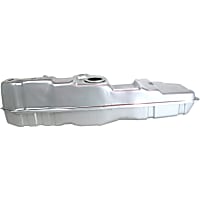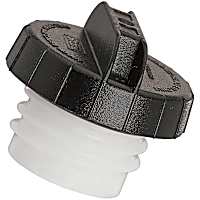In this article, we’ll explain what a P0442 means, what the possible causes and symptoms are, and how you can go about diagnosing and fixing the issue.
What Does the P0442 Code Mean?
Diagnostic trouble code (DTC) P0442 stands for “Evaporative Emission Control System Leak Detected (Small Leak)”. Your car’s computer will set the code when it determines there’s a minor leak somewhere in the evaporative emission control (EVAP) system.

What are the Possible Causes of the P0442 Code?
The most common causes of P0442 code are the following:
- Malfunctioning fuel cap
- Leak or damage in the EVAP system line
- Leak or damage in the charcoal canister
- Leak or damage in the fuel tank
- Malfunctioning vent valve (leaking internally)
- Malfunctioning purge valve (leaking internally)
- Faulty FTP sensor
- Failed leak detection pump

What are the Common Symptoms of the P0442 Code?
Typically, the most common symptoms you are most likely to experience if your vehicle is triggering the OBD-II trouble code P0442 would be an illuminated Check Engine Light or increased vehicle emissions.
In some cases, you may notice some pronounced fuel odors, although this is less common.

How to Diagnose the P0442 Code
When dealing with a P0442 code, the first thing a layperson should do is make sure the fuel cap is on tight, because if it’s loose, that could easily trigger the code.
If tightening the cap doesn’t work, you may want to try purchasing and installing a new cap.
Shops typically use a special machine that pumps the EVAP system full of smoke, which helps tremendously, in finding EVAP system leaks, but P0442 codes can be extremely difficult to find, even for a well-equipped shop. If you have recently hit something in the road or if you’ve had animals chewing on hoses and lines you might be able to spot damage by just doing a visual inspection. Check for split or disconnected hoses and/or broken plastic parts.
Keep in mind: once you’ve tightened or replaced the gas cap, you’ll have to clear the code with a code reader or scan tool afterward. The code won’t immediately go away on its own.
Other than the gas cap, there are numerous potential causes that can trigger the OBD-II code P0442. As such, diagnosis can be difficult. For an idea of how to troubleshoot the code, check out the videos below:
How to Fix the P0442 Code
There are multiple underlying causes that could trigger a code P0442. Therefore, there isn’t a “magic bullet” fix for the issue. You can try tightening or replacing the gas cap, as mentioned, or perhaps even do a visual inspection of the EVAP system components to check for any physical damage that could be causing a leak.
Other than that, you’ll need to diagnose the code accurately, as outlined above, to be able to perform the most appropriate repair for your specific case.
Also, keep in mind that all cars are different, so when troubleshooting and repairing diagnostic trouble codes, make sure to consult the factory repair information for your application.
Repair manuals, such as those from Chilton, are useful, but an ALLDATA subscription is even better. ALLDATA has single-vehicle subscriptions for DIYers that provide detailed factory repair information.
What is an EVAP System?
The EVAP system’s primary purpose is to block fuel vapors from escaping into the atmosphere. Although system designs vary, common primary components found within this system include the fuel tank, gas cap, purge valve, vent valve, and EVAP (charcoal) canister.
An In-Depth Look at Evaporative Systems
Evaporative systems have been around since California began requiring EVAP systems on cars in 1970. The gas smell from your fuel tank – hydrocarbon vapors from evaporating gasoline – is captured and stored in a special canister filled with fibrous material. A small vapor line runs from the top of the fuel tank to the canister, which retains the hydrocarbon vapors until they are purged by engine vacuum through a special valve. The canister has an open vent that allows atmosphere to flow through the canister as engine vacuum is applied to the canister’s purge port. A person who “packs” gas into their tank can cause the canister to become saturated with fuel, causing drivability issues like odd stumbles when the canister begins to purge.
Early canister purge valves had a ported vacuum line that triggered the purge valve to open a path from the canister to engine vacuum. “Ported” vacuum is only delivered when the throttle is applied but never at idle.
From 1970 to the mid 1990s, EVAP systems remained almost unchanged other than some OEMs using electric purge valves rather than vacuum triggered ones. With OBD2 regulations that became mandatory on all cars and trucks by 1997, EVAP systems got an upgrade. Some EVAP systems measured EVAP system flow using a thermistor or some other method. Enhanced EVAP systems were designed to detect vapor leaks as small as 0.020 (twenty thousandths) inch. While the older EVAP purge valves never opened at idle, modern EVAP systems are just as likely to purge the canister idling as they are driving down the road.
Rather than the canister being vented at all times, the most commonly described type of EVAP system monitor has a normally open electrically operated vent valve that is energized by the ECM/PCM to close the canister vent while a very gentle vacuum is applied to the canister through the purge valve, which the ECM/PCM operates using a duty cycle.
Since the hoses and the fuel tank are isolated from atmosphere at this point along with the canister, this gentle leak test maneuver traps that very weak vacuum in the fuel tank and the vapor lines and the ECM/PCM measures the negative pressure via a three-wire tank pressure sensor while the vacuum is applied. The ECM/PCM then closes the purge valve, trapping the vacuum in the system and watching the pressure. If the pressure leaks up a certain amount within a specified time interval, a code is stored by the ECM/PCM. A P0442 basically means a small leak has been detected.
Other Notes About P0442
It’s important to note that not all vehicles include a P0442 in their code library – most new Toyotas don’t include a P0442.
It’s important to note that not all vehicles include a P0442 in their code library – most new Toyotas don’t include a P0442.
–Richard McCuistian, ASE Certified Master Automobile Technician
Furthermore, EVAP systems operate in several different ways besides the method described above, but every EVAP leak test is obviously designed to find EVAP leaks. Some systems have special valve assemblies dedicated to vapor leak detection.
These systems basically work as follows: During vehicle operation, exhaust system heat is transferred to the fuel tank by default. With the key OFF and the EVAP system sealed, a change in the fuel tank vapor temperature and pressure naturally occurs. This pressure change is monitored by the ECM using the fuel tank pressure sensor input to determine whether there is an EVAP leak.
We don’t have room here to discuss all the different ways OEMs use to detect small EVAP leaks, but you get the picture.
Get a Replacement Vapor Canister that Fits Your Car
When the vapor canister leaks and causes the P0442 code, you must replace it immediately. Exhaust issues are costly and might affect the engine, potentially making the repair job even more expensive. Let CarParts.com help you get the replacement vapor canister you need.
At CarParts.com, we ensure you can find the appropriate vapor canister for your car or truck. Our website features an easy-to-use vehicle selector that lets you search from our extensive catalog of parts and accessories by year, make, model, and engine. All our products come from trusted brands, so you know you’re getting a long-lasting part that performs as promised. They’re also ready to ship from our strategically located warehouses, ensuring that you don’t have to wait more than a few business days for your order to arrive at your doorstep.
Browse our wide array of vapor canisters and EVAP system parts here at CarParts.com. Shop for our products today and choose a vapor canister that fits your application!
Products Mentioned in this Guide
Any information provided on this Website is for informational purposes only and is not intended to replace consultation with a professional mechanic. The accuracy and timeliness of the information may change from the time of publication.



 Fuel Tank
Fuel Tank
 Fuel Tank Vent Valve
Fuel Tank Vent Valve
 Gas Cap
Gas Cap
 Purge Valve
Purge Valve

















P0442 My mechanic solved it by disassembling the gas tank, he changed a viton seal that is submerged in the tank. I ordered this stamp to be prepared according to the model.
Pedro,
What sort of “stamp” did you order? And what is it’s purpose?
I solved the 442 code by not over filling the gas tank..as soon as it clicks off stop. Never had the code again. After replacing parts and other things that did not work. If I over fill the gas tank? It takes a little time then the engine light comes on. Don’t over fill your gas tank. A free fix.